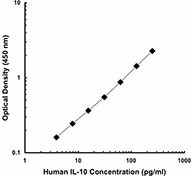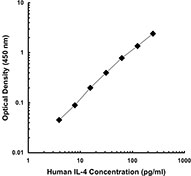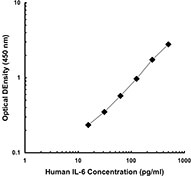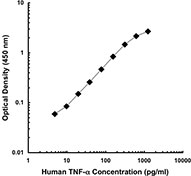- Clone
- JES3-12G8 (See other available formats)
- Regulatory Status
- RUO
- Other Names
- Interleukin-10, B cell derived T cell growth factor (B-TCGF), Cytokine synthesis inhibitory factor (CSIF), T-cell growth inhibitory factor (TGIF)
- Isotype
- Rat IgG2a, κ
- Ave. Rating
- Submit a Review
- Product Citations
- publications

| Cat # | Size | Price | Save |
|---|---|---|---|
| 501501 | 50 µg | ¥22,220 | |
| 501502 | 500 µg | ¥60,280 |
IL-10 was originally described as Cytokine Synthesis Inhibitory Factor (CSIF) by virtue of its ability to inhibit cytokine production by Th1 clones. IL-10 shares over 80% sequence homology with the Epstein-Barr virus protein BCRFI. The biological activities of IL-10 include inhibition of macrophage-mediated cytokine synthesis, suppression of the delayed type hypersensitivity response, and stimulation of the Th2 cell response, which results in elevated antibody production. The JES3-12G8 antibody reacts with human and viral interleukin-10 (IL-10). The JES3-12G8 antibody can neutralize the bioactivity of natural or recombinant IL-10.
Product DetailsProduct Details
- Reactivity
- Human
- Antibody Type
- Monoclonal
- Host Species
- Rat
- Immunogen
- COS - expressed, recombinant human IL-10
- Formulation
- Phosphate-buffered solution, pH 7.2, containing 0.09% sodium azide.
- Preparation
- The antibody was purified by affinity chromatography, and conjugated with biotin under optimal conditions.
- Concentration
- 0.5 mg/ml
- Storage & Handling
- The antibody solution should be stored undiluted between 2°C and 8°C. Do not freeze.
- Application
-
ELISA Detection, ELISPOT Detection
- Recommended Usage
-
Each lot of this antibody is quality control tested by ELISA assay. For ELISA detection applications, a concentration range of 0.25-1.0 µg/ml is recommended. To obtain a linear standard curve, serial dilutions of IL-10 recombinant protein ranging from 500 to 2 pg/ml are recommended for each ELISA plate. For use as an ELISPOT detection antibody, a concentration range of 1-4 µg/ml is recommended. It is recommended that the reagent be titrated for optimal performance for each application.
- Application Notes
-
ELISA Detection1-4 or ELISPOT Detection5: The biotinylated JES3-12G8 antibody is useful as a detection antibody in a sandwich ELISA or ELISPOT assay, when used in conjunction with the Ultra-LEAF™ purified JES3-9D7 antibody (Cat. Nos. 501427 & 501428) or purified JES3-19F1 antibody (Cat. No. 506802/506810) as capture antibody and recombinant human IL-10 (Cat. No. 571009) as the standard.
Additional reported applications (for the relevant formats) include: immunohistochemical staining6,7 of paraformaldehyde-fixed, saponin-treated frozen tissue sections, neutralization, and immunocytochemistry.
Note: For testing human IL-10 in serum or plasma, BioLegend's ELISA Max™ Sets (Cat. Nos. 430601 & 430606) are specially developed and recommended. -
Application References
(PubMed link indicates BioLegend citation) -
- Abrams, J., et al. 1992. Immunol. Rev. 127:5.
- Gotlieb, W., et al. 1992. Cytokine 4:385. (ELISA)
- Yssel, H., et al. 1992 J. Immunol. 149:2378. (ELISA)
- Burdin, N., et al. 1993. J. Exp. Med. 177:295. (ELISA)
- Klinman, D., et al. 1994. Curr. Prot. Immunol.. John Wiley and Sons, New York. Unit 6.19.
- Tazi, A., et al. 1999. J. Immunol.163:3511
- Andersson, J., et al. 1994. Immunology 83:16. (IHC)
- Product Citations
- RRID
-
AB_315177 (BioLegend Cat. No. 501501)
AB_315178 (BioLegend Cat. No. 501502)
Antigen Details
- Structure
- Acid-labile cytokine; dimer; 35-40 kD (Mammalian)
- Bioactivity
- Inhibit IFN-γ, TNF-β, IL-2 production by TH1 clones; inhibits macrophage-mediated IL-1, IL-6, TNF-α synthesis; suppress delayed type hypersensitivity response; stimulate TH2 cell response; mast cell proliferation in
- Cell Sources
- Activated CD8+ and CD4+ T cells, activated monocytes, mast cells, Ly-1 B (mouse)
- Cell Targets
- T cells, B cells, mast cells, macrophages
- Receptors
- IL-10R (CDw210)
- Cell Type
- Tregs
- Biology Area
- Cell Biology, Immunology, Neuroinflammation, Neuroscience
- Molecular Family
- Cytokines/Chemokines
- Antigen References
-
1. Fitzgerald, K., et al. Eds. 2001. The Cytokine FactsBook. Academic Press, San Diego.
2. de Waal-Malefyt, R., et al. 1992. Curr. Opin. Immunol. 4:314.
3. Howard, M., et al. 1992. Immunol. Today. 13:198.
4. Quesniaux, V. 1992. Research Immunol. 143:385. - Regulation
- Production inhibited by IL-4, IL-10
- Gene ID
- 3586 View all products for this Gene ID
- UniProt
- View information about IL-10 on UniProt.org
Related FAQs
- How many biotin molecules are per antibody structure?
- We don't routinely measure the number of biotins with our antibody products but the number of biotin molecules range from 3-6 molecules per antibody.
Customers Also Purchased



Compare Data Across All Formats
This data display is provided for general comparisons between formats.
Your actual data may vary due to variations in samples, target cells, instruments and their settings, staining conditions, and other factors.
If you need assistance with selecting the best format contact our expert technical support team.













Follow Us